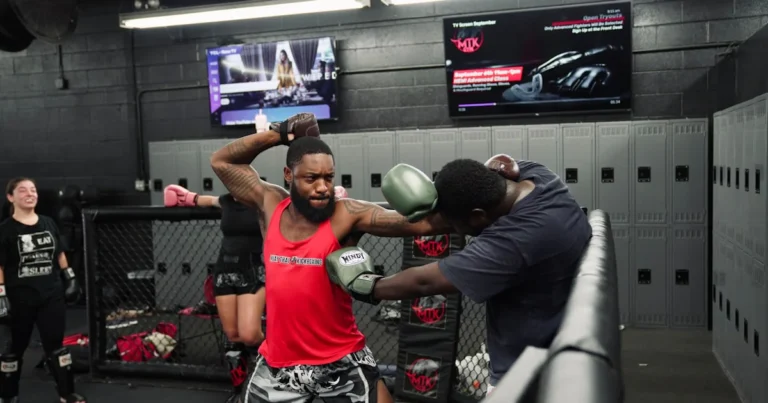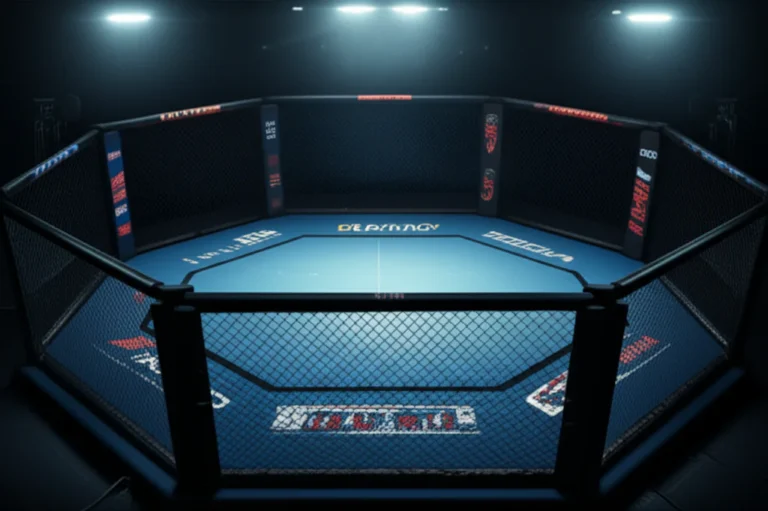Support our educational content for free when you purchase through links on our site. Learn more
What is an MMA Fighter? Discover the Secrets Behind the Cage Warriors [2024] 🥋
Have you ever watched an MMA fight and wondered what it takes to become one of those fierce competitors? The world of Mixed Martial Arts is not just about throwing punches and grappling; it’s a complex arena where strategy, discipline, and sheer grit collide. In this article, we’ll dive deep into the life of MMA fighters, exploring their training regimens, the evolution of the sport, and the organizations that shape their careers. Did you know that the UFC alone has turned ordinary athletes into global superstars? 🌟
Let’s take a journey through the fascinating history of MMA, the diverse disciplines fighters master, and the safety measures in place to protect these modern gladiators. You might be surprised to learn how far the sport has come from its bare-knuckle roots! So, whether you’re an aspiring fighter, a dedicated fan, or just curious about the sport, we’ve got you covered!
Key Takeaways
- MMA Fighters Are Multi-Disciplinary Athletes: They combine various martial arts like boxing, Brazilian Jiu-Jitsu, and Muay Thai to create a diverse skill set.
- Safety is Paramount: Modern MMA is heavily regulated with strict rules and medical oversight to ensure fighter safety.
- Women Are Making History: Female fighters are breaking barriers and achieving incredible success in the sport.
- The Path to Professionalism: Many top fighters start in amateur leagues, showcasing the importance of a solid foundation.
- Major Organizations Matter: The UFC, Bellator, and ONE Championship are key players in shaping fighters’ careers and the sport’s future.
Ready to gear up for your own MMA journey? 👉 Shop MMA Gear on:
Dive into the world of MMA and discover what it truly means to be a fighter! 💪
Table of Contents
- Quick Tips and Facts
- Understanding the MMA Fighter: What Makes Them Unique?
- A Brief History of Mixed Martial Arts Fighters
- Timeline of Major Events in MMA Fighting
- The Evolution of the Modern MMA Fighter
- Top MMA Organizations Shaping Fighters’ Careers
- Rules Every MMA Fighter Must Know
- Common Disciplines Practiced by MMA Fighters
- Basic Strategies for Aspiring MMA Fighters
- Women in MMA: Breaking Barriers and Making History
- The Rise of Amateur MMA Fighters
- Safety First: Protecting MMA Fighters
- Legality of Professional MMA Competitions
- Notes on MMA Fighters and Their Training
- Conclusion
- Recommended Links
- FAQ
- Reference Links
1. Quick Tips and Facts 👊
- MMA stands for Mixed Martial Arts. Pretty straightforward, right? 😉
- MMA fighters are modern-day gladiators, trained in various martial arts disciplines. Think Bruce Lee but with weight classes and sponsorships!
- It’s not just about brute strength. Strategy, technique, and fight IQ are just as important. Ever seen a smaller fighter dominate a larger opponent? Technique! 🧠
- MMA is heavily regulated to ensure fighter safety. Gone are the days of the “no holds barred” era.
- Want to see the best of the best? Check out the The 10 Greatest MMA Fighters of All Time 2024🥇.
2. Understanding the MMA Fighter: What Makes Them Unique?
MMA fighters aren’t your average athletes. They’re a unique breed, forged in the crucible of intense training and relentless competition. Here at MMA Ninja™, we’ve seen firsthand what makes these warriors tick.
The Multi-Disciplinary Approach
Unlike athletes specializing in a single discipline, MMA fighters are masters of many. They seamlessly blend striking arts like Boxing and Muay Thai with grappling arts like Brazilian Jiu-Jitsu and Wrestling. This “hybrid” approach makes them incredibly adaptable and dangerous in the cage.
Mental Fortitude
Imagine stepping into a cage with another trained fighter, knowing millions are watching. The mental pressure is immense. MMA fighters possess an unwavering will to win, pushing their physical and mental limits.
A Neverending Grind
Becoming an MMA fighter isn’t a walk in the park. It demands years of dedicated training, often twice a day, every day. We’re talking strength and conditioning, sparring, drilling techniques, and studying fight footage. It’s a full-time commitment, demanding sacrifices most wouldn’t even consider.
3. A Brief History of Mixed Martial Arts Fighters

The roots of MMA run deep, intertwining with ancient combat forms and evolving over centuries. Let’s take a trip down memory lane, shall we?
Ancient Origins
Believe it or not, the concept of mixing fighting styles isn’t new. Ancient Greece had Pankration, a brutal no-holds-barred competition. Centuries later, forms of mixed combat emerged in Japan and Brazil, laying the groundwork for what we now know as MMA.
The Rise of Vale Tudo
In the early 20th century, Brazil became a hotbed for Vale Tudo, which translates to “anything goes.” These bare-knuckle brawls pitted fighters from different disciplines against each other, often with minimal rules. It was a raw and visceral spectacle that captivated audiences.
The Birth of the UFC
In 1993, the Ultimate Fighting Championship (UFC) burst onto the scene, forever changing the landscape of combat sports. The early UFC events were a proving ground for different martial arts styles, with the goal of determining the most effective in a real fight.
4. Timeline of Major Events in MMA Fighting
To truly grasp the evolution of MMA fighters, let’s look at some pivotal moments that shaped the sport:
- 1951: Masahiko Kimura, a Judo legend, submits Hélio Gracie, a pioneer of Brazilian Jiu-Jitsu, in a highly publicized match in Brazil. This event helped demonstrate the effectiveness of grappling arts.
- 1976: Boxing icon Muhammad Ali faces off against wrestling superstar Antonio Inoki in a highly anticipated but controversial “mixed-rules” bout. While not technically MMA, it fueled the debate about inter-style matchups.
- 1993: The inaugural UFC event takes place, introducing the world to the raw intensity of no-holds-barred fighting. Royce Gracie, a Brazilian Jiu-Jitsu practitioner, dominates the competition, showcasing the power of ground fighting.
- Late 1990s – Early 2000s: The UFC faces intense scrutiny and political pressure, leading to the implementation of unified rules and weight classes to improve fighter safety and the sport’s image.
- 2005: The Ultimate Fighter, a reality show featuring aspiring MMA fighters, debuts, bringing the sport into the mainstream and attracting a new generation of fans.
- 2016: The UFC is purchased by WME-IMG (now Endeavor) for a staggering $4 billion, solidifying MMA’s status as a global sports and entertainment powerhouse.
5. The Evolution of the Modern MMA Fighter
Gone are the days when a fighter could specialize in a single discipline and expect to reign supreme. Today’s MMA fighters are well-rounded athletes, constantly evolving to stay ahead of the curve.
Specialization Within a Specialty
While fighters still have their strengths, they’re no longer just “boxers” or “wrestlers.” They’ve become specialists within their specialties. For example, a fighter with a strong wrestling base might also excel in Brazilian Jiu-Jitsu, creating a formidable ground game.
Data-Driven Training
Remember those fight footage study sessions we mentioned? They’ve gotten a serious upgrade. Modern MMA fighters and their coaches use sophisticated data analytics to dissect opponents, identify weaknesses, and develop game plans.
Emphasis on Strength and Conditioning
Today’s MMA fighters are bigger, stronger, and faster than ever before. Strength and conditioning programs have become an integral part of training, focusing on explosiveness, endurance, and injury prevention.
6. Top MMA Organizations Shaping Fighters’ Careers
The world of MMA is a competitive landscape, with numerous organizations vying for talent and fan attention. Here are a few of the major players:
- Ultimate Fighting Championship (UFC): The undisputed king of MMA, the UFC boasts the best fighters in the world, massive pay-per-view events, and a global fanbase.
- Bellator MMA: A worthy competitor to the UFC, Bellator has been steadily building its roster and attracting top-tier talent.
- ONE Championship: Based in Asia, ONE Championship is known for its unique ruleset, which allows for both MMA and Muay Thai bouts. They’ve been gaining significant traction in recent years.
- Professional Fighters League (PFL): PFL differentiates itself with a season-based format, culminating in a million-dollar prize for the winner of each weight class.
7. Rules Every MMA Fighter Must Know
While MMA might seem chaotic to the uninitiated, it’s actually governed by a strict set of rules designed to ensure fair play and fighter safety.
The Unified Rules of MMA
Most major MMA organizations, including the UFC, adhere to the Unified Rules. These rules outline:
- Weight Classes: Fighters compete against opponents in their weight class to ensure fairness.
- Legal Techniques: Strikes, takedowns, and grappling submissions are permitted, but certain techniques, such as eye gouging and groin strikes, are strictly prohibited.
- Fouls: Intentional fouls can result in point deductions or even disqualification.
- Judging Criteria: Judges score rounds based on effective striking, grappling control, aggression, and fight IQ.
8. Common Disciplines Practiced by MMA Fighters
MMA fighters are like walking, talking arsenals of martial arts techniques. Here’s a glimpse into their training regimen:
Striking
- Boxing: Footwork, head movement, and punching combinations are essential for any MMA fighter.
- Muay Thai: Known for its devastating kicks, knees, elbows, and clinch work, Muay Thai adds a brutal dimension to a fighter’s striking arsenal.
- Kickboxing: Combining punches and kicks, kickboxing helps develop speed, power, and distance management.
Grappling
- Brazilian Jiu-Jitsu (BJJ): This grappling art focuses on leverage and technique to control and submit opponents on the ground.
- Wrestling: Essential for takedowns, takedown defense, and controlling opponents on the mat. Wrestlers often dictate where a fight takes place.
Other Martial Arts
While not as common, some fighters incorporate elements of Judo, Sambo, Karate, and Taekwondo into their game.
9. Basic Strategies for Aspiring MMA Fighters
So, you want to be an MMA fighter? Buckle up, rookie. It’s a long and challenging road, but here are a few pointers to get you started:
- Find a Reputable Gym: Training with experienced coaches and training partners is crucial for your development.
- Master the Fundamentals: Don’t get caught up in fancy techniques before you’ve mastered the basics of striking, takedowns, and ground control.
- Develop Your Fight IQ: Learn to anticipate your opponent’s moves, exploit weaknesses, and make adjustments during a fight.
- Embrace the Grind: Success in MMA requires unwavering dedication, discipline, and a high tolerance for pain.
10. Women in MMA: Breaking Barriers and Making History

For years, MMA was considered a male-dominated sport. Not anymore. Women are shattering glass ceilings and cementing their legacy in the octagon.
Pioneers of Women’s MMA
We can’t talk about women in MMA without mentioning trailblazers like Gina Carano, Cristiane “Cyborg” Justino, and Megumi Fujii. These women paved the way for future generations.
The Ronda Rousey Era
Ronda Rousey’s dominance in the UFC revolutionized women’s MMA. Her aggressive fighting style and captivating personality brought unprecedented attention to the sport.
A New Generation of Stars
Today, women’s MMA is more competitive than ever. Fighters like Amanda Nunes, Valentina Shevchenko, and Weili Zhang are captivating audiences with their skill and athleticism.
11. The Rise of Amateur MMA Fighters
Amateur MMA is where future stars hone their skills and prepare for the professional ranks. It’s a crucial stepping stone, providing a safe and competitive environment.
International Mixed Martial Arts Federation (IMMAF)
The IMMAF is the leading organization for amateur MMA, hosting world championships and promoting the sport globally.
Path to Professionalism
Many top professional fighters, including Conor McGregor and Jon Jones, started their journeys in the amateur ranks. It’s a testament to the importance of a strong foundation.
12. Safety First: Protecting MMA Fighters
MMA is an inherently dangerous sport, but significant strides have been made to improve fighter safety.
Medical Supervision
Fighters undergo rigorous medical testing before, during, and after fights. Ringside physicians are present to assess injuries and stop fights if necessary.
Rule Changes
Over the years, rules have been implemented to reduce the risk of serious injury. Illegal techniques, such as headbutts and soccer kicks, have been banned.
Ongoing Research
Research into the long-term effects of head trauma in MMA is ongoing. Organizations like the Cleveland Clinic’s Lou Ruvo Center for Brain Health are studying ways to improve fighter safety and well-being.
13. Legality of Professional MMA Competitions
MMA has come a long way since its early days of being labeled “human cockfighting.” Today, it’s a regulated and sanctioned sport in most parts of the world.
United States
MMA is legal in all 50 states, regulated by state athletic commissions.
International Recognition
MMA is gaining acceptance worldwide, with organizations like the IMMAF working towards Olympic inclusion.
14. Notes on MMA Fighters and Their Training
Training for MMA is a multifaceted endeavor. Here are some key insights:
Consistency is Key
MMA fighters train consistently, often dedicating 20-30 hours a week to various disciplines. This includes striking, grappling, strength training, and cardio.
Nutrition Matters
A well-balanced diet is crucial for optimal performance. Fighters often work with nutritionists to create meal plans that fuel their training and recovery.
Mental Training
Mental conditioning is as important as physical training. Fighters often engage in visualization techniques, meditation, and sports psychology to enhance their focus and resilience.
Conclusion

In summary, MMA fighters are not just athletes; they are multifaceted warriors trained in various martial arts disciplines, constantly adapting and evolving to stay competitive in a fast-paced sport. From the gritty history of bare-knuckle brawls to the highly regulated and celebrated events we see today, MMA continues to captivate audiences worldwide.
Positives:
- Diverse Skill Sets: Fighters are well-versed in striking and grappling techniques, making for electrifying matches.
- Regulated Safety Standards: Modern rules and medical oversight ensure fighter safety, allowing for a more legitimate sport.
- Growing Popularity: Organizations like the UFC and Bellator are elevating the sport, bringing in new fans and opportunities for fighters.
Negatives:
- Physical Risks: Despite safety measures, MMA remains a contact sport with inherent risks of injury.
- Public Perception: Despite its growth, MMA still faces skepticism from some who view it as too violent.
Recommendation: If you’re considering diving into the world of MMA, whether as a fighter or a fan, we wholeheartedly recommend exploring the sport. It’s a thrilling blend of athleticism, strategy, and raw emotion that you won’t want to miss!
Recommended Links
If you’re eager to learn more or gear up for your own MMA journey, check out these links:
- 👉 Shop MMA Gear on:
- Books on MMA:
FAQ

What is MMA and why is it banned?
MMA, or Mixed Martial Arts, is a full-contact combat sport that combines elements of various martial arts and fighting styles. While it has gained popularity, it faced bans in several regions during its early days due to concerns about violence and safety. However, these bans have largely been lifted as regulations and safety measures have been implemented.
Read more about “What is MMA and why is it banned?”
What kind of fighting is in MMA?
MMA incorporates a wide range of fighting styles, including striking techniques from boxing, kickboxing, and Muay Thai, as well as grappling techniques from Brazilian Jiu-Jitsu, wrestling, and judo. Fighters must be proficient in both stand-up fighting and ground fighting to succeed.
Read more about “The 10 Greatest MMA Fighters of All Time … 🏆”
How is MMA different from martial arts?
While martial arts refers to various systems of combat training, MMA is a specific sport that combines multiple martial arts disciplines into a competitive format. In other words, MMA is a hybrid form of martial arts, focusing on practical application in a fight setting.
Read more about “Can a Karate Guy Beat a Boxer? 10 Reasons to Consider in 2024! 🥊🥋”
Are MMA fights legal?
Yes, MMA fights are legal in most countries, including all 50 states in the USA, where they are regulated by state athletic commissions. These organizations enforce rules to ensure fighter safety and fair competition.
Read more about “Street Fighting Techniques: Master the Art of Self-Defense … 🥋”
What are the most popular MMA organizations?
The most popular MMA organizations include the Ultimate Fighting Championship (UFC), Bellator MMA, and ONE Championship. Each organization has its own unique rules, fighters, and fanbases.
Read more about “The Hidden Legacy of MMA Founders: Unveiling 10 Pioneers Who Shaped the Sport 🥋 …”
What is the role of weight classes in MMA?
Weight classes in MMA ensure that fighters compete against opponents of similar size and weight, promoting fairness and safety. This classification helps prevent mismatches that could lead to serious injuries.
Reference Links
- Wikipedia – Mixed Martial Arts
- Wikipedia – Mixed Martial Arts in the United States
- International Mixed Martial Arts Federation
- Ultimate Fighting Championship Official Site
- Bellator MMA Official Site
With this guide, you’re now equipped with a wealth of knowledge about MMA fighters, their training, and the sport’s evolution. So go ahead, dive in, and maybe even consider stepping into the cage yourself! 🥋💪




